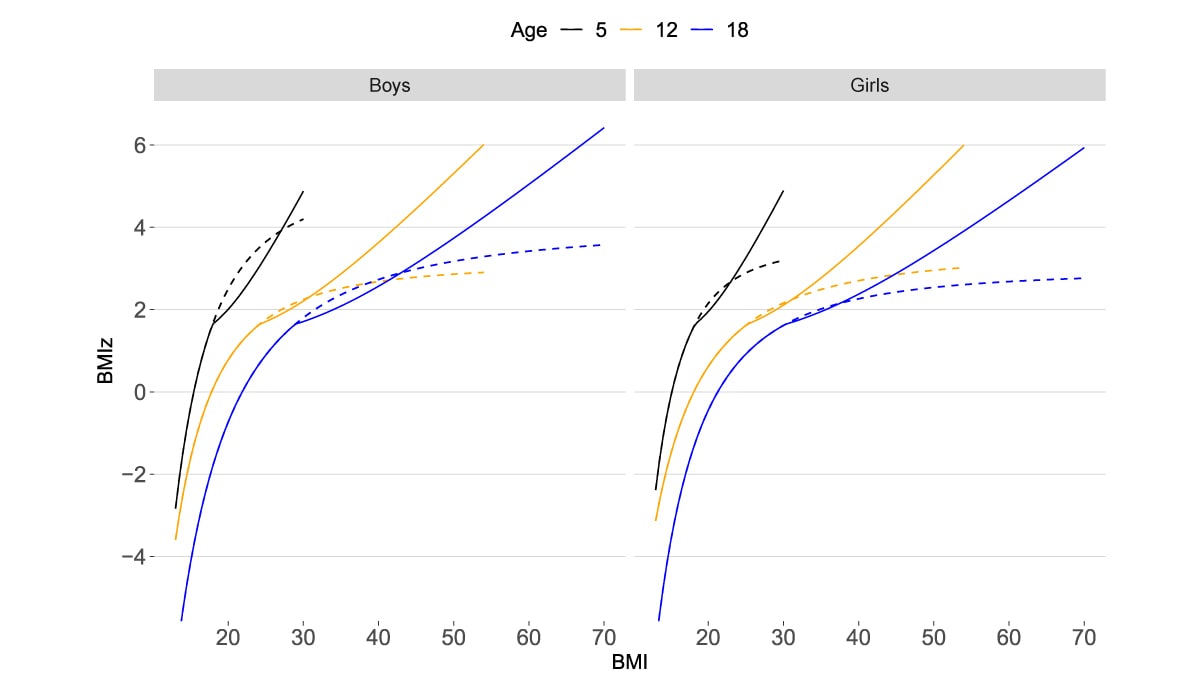Purpose
CDC Growth Charts are used to monitor growth in children and adolescents 2 to 20 years. This page compares the 2000 CDC BMI-for-Age Growth Charts to the 2022 CDC Extended BMI-for-Age Growth Charts. The extended charts are used if children and adolescents have very high BMIs (above the 97th percentile).

BMI-for-age growth charts comparison
Health care providers use BMI-for-age growth charts to continuously measure growth of children and adolescents 2 years to 20. These data inform the clinical care that children receive.
The 2000 CDC BMI-for-Age Growth Charts have a maximum plottable BMI of 37 kg/m2, which means that they have no percentile lines above the 95th percentile. This makes these growth charts less useful as a visual growth tracking resource for children with severe obesity.
Consequently, CDC expanded the growth charts using more recent data and methods. The 2022 CDC Extended BMI-for-Age Growth Charts rely on an updated reference population and updated statistical methods. This allows for plotting BMIs above the 97th percentile (98th, 99th, 99.9th, 99.99th). The extended growth charts, coupled with quality treatment, can help optimize care for children with severe obesity.
The CDC Child and Teen BMI Calculator calculates and plots BMIs below and above the 95th percentile.
| 2000 CDC BMI-for-Age
Growth Charts |
2022 CDC Extended BMI-for-Age
Growth Charts |
|---|---|
| Are based on reference data during 1963–80, a period when obesity prevalence was lower than today. | Include additional reference data for children with obesity during 1999–2016. |
| Have a maximum plottable BMI of 37 kg/m2. | Have a maximum plottable BMI of 60 kg/m2. |
| Do not show percentile curves above the 95th percentile. | Add four percentile curves above the 95th percentile (98th, 99th, 99.9th, 99.99th). |
| Are not recommended for use in children with BMIs above the 97th percentile. | Use updated statistical methods to calculate BMI percentiles for children with very high BMIs. |
| No color shading | Use color shading as a visual aid for clinicians and families. |
Test your knowledge
- Why were the 2022 CDC Extended BMI-for-Age Growth Charts created?
- The 2000 CDC BMI-for-Age Growth Charts were based on reference data from a period when obesity prevalence was much lower than it is today.
- The 2000 CDC BMI-for-Age Growth Charts had a maximum plottable BMI of 37 kg/m2.
- The 2000 CDC BMI-for-Age Growth Charts did not display percentile curves above the 95th percentile.
- All of the above
- The 2000 CDC BMI-for-Age Growth Charts were based on reference data from a period when obesity prevalence was much lower than it is today.
- The 2022 CDC Extended BMI-for-Age Growth Charts display four additional percentile curves above the 95th percentile to help plot and track growth of children with very high BMIs.
- True
- False
- True
See answers.A
- Question 1: D. All of the above are reasons why CDC created the Extended BMI-for-Age Growth Charts. Question 2: True. The Extended BMI-for-Age Growth Charts add four percentile curves above the 95th percentile (98th, 99th, 99.9th, 99.99th).
